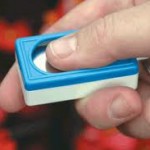So You Bought Yourself a Clicker…Now What?
February 25, 2014
he world of dog training is changing. The average dog owner is no longer just the tie-him-out-back-and-throw-him-some-meat kind of owner. People are becoming more educated, better supplied, and more involved than ever before and, as a result, they’re looking for even better ways to get results with their dogs.
You want to know where this quest for “better” always seems to end up?
The clicker.
Let me be the first to tell you that I’m not a “clicker” trainer. I have colleagues that leave my technical skills in a pile of embarrassing dust. Nonetheless, I’ll be the first to tell you that you’ll get results faster and your training experience will improve exponentially if you decide to take the plunge. A lot of our clients come to class saying they bought a clicker when they first bought their puppy but were never really sure how to use it or what it actually DOES, so it’s been sitting in the junk drawer for six months next to a half-used bottle of crazy glue.
This is where we come in.
Who Invented the Clicker Anyway?
“What the dog trainers are calling clicker training is an application of behavior analysis that was initially invented and developed more than thirty years ago, by Keller Breland, Marian Breland Bailey, and Bob Bailey. It first reached widespread use in the training of marine mammals…Although the marine mammal trainers use a whistle, not a clicker, their training relied on the same principles and is really exactly the same as what people are now calling clicker training.” (History of Clicker Training, Karen Pryor)
What exactly IS the Clicker?
 The clicker is a small, usually plastic device about the size of a box of raisins. Some clickers have buttons, and others have a tab that resembles the inside of the lid from a bottle of orange juice. Some are loud, some are quiet, and some even have lights attached. When one presses the button or the tab, it makes a distinct “click” noise. It’s this tiny little noise that can change your world my friends.
The clicker is a small, usually plastic device about the size of a box of raisins. Some clickers have buttons, and others have a tab that resembles the inside of the lid from a bottle of orange juice. Some are loud, some are quiet, and some even have lights attached. When one presses the button or the tab, it makes a distinct “click” noise. It’s this tiny little noise that can change your world my friends.
Ok, so WHY Does it Work?
The clicker itself is meaningless to our dogs when they first see it. Big deal. A little plastic thing. A decent chew toy perhaps to some dogs, but pretty boring. The clicker becomes valuable when we “load the click”. This means that we pair the sound of the click with a treat enough times that the sound of the click itself becomes REALLY awesome to your dog…why? because it means a treat is coming!!! If you give me twenty bucks every time you show me a picture of Ryan Gosling I’m going to really start to like seeing pictures of Ryan Gosling (wait, bad example).

You’re welcome.
The point is that the clicker quickly becomes a way to mark behaviour that you like EXACTLY when it happens. As a result, your dog has to guess a lot less about what it is that you like (which is amazing, since most of us are appallingly unclear about our expectations). If you’ve taken enough time to “load the click” then your dog’s head will whip around every time he hears that noise…it’s when you know you’re ready to get started. Conversely, if you click and your dog doesn’t even seem to notice, then you need to spend a little more time pairing the sound with a treat.
After all this time working with clients that are just learning the art of the clicker, I’ve noticed some very common, and extremely understandable, mistakes (shall we call them hiccups?). I feel that the job falls to me, dear readers, to lay the ground rules. To “tell it like it is”. To set you all on the straight and narrow. Hopefully, once you iron out the kinks you’ll be giving Karen Pryor (the DogMother of clicker training) a run for her money.
Rule #1: One Click=One Treat
For some reason there are different opinions on this one. For me, it makes perfect sense. When you first start clicking and your dog is doing something you really like you’re going to turn into some kind of Clicker-slinging James Dean because you get so excited! If he offers a sit, you might click him three times in a row just so that he knows how awesome he was. Bad idea. Every time you click and DON’T deliver a treat, you’ve weakened the value of that noise (remember, it’s only awesome because it’s paired with treats).
Rule # 2: If you click, you HAVE to Treat
Your timing will be a bit, how do we say, crappy….in the beginning. This means you might click a bit early or a bit late and wish you hadn’t. Unfortunately, if you click by accident you still have to deliver that treat. I don’t care if you accidentally clicked your dog for pooping on your new rug; you have to pair it with a treat. This will make you much more mindful of when you deliver the click!
Rule #3: The Click is Not Used to Get Your Dog’s Attention
Your dog will LOVE the sound of the clicker. As a result, it will be really (and I mean REALLY) tempting to click when he’s not paying attention to you because you know he’ll turn to look at you. Bear this in mind; whatever he was doing at the exact moment you clicked is the behaviour you reinforced him for! That means that if he’s just picked up a “poopsicle” in the yard and you click, he’ll be more likely to repeat that behaviour. Yeesh.
Rule #4: Get Your Hands out of Your Treat Pouch!
Dogs make a LOT of associations. If you reach for your treat pouch before you click, you think your dog is likely to even hear the click? Not a chance. Instead of using the click to predict a reward, your dog will be looking to see whether you’re reaching into your pouch or pocket. We want the CLICK to be the predictor of a reward. To avoid this little conundrum, keep your hands at “home base” (as my trainer friend Mirkka taught me) between each repetition. For most people the hand flat on the thigh works well. Think Click…Reach…Deliver…Back to home base. Click…Reach…Deliver…Back to home base.
I’m sure every single trainer will tell you their most important “Clicker Rules”, and guess what, they’ll all be different. This should give you a nice place to get started and hopefully inspire you to do some research of your own! Take this as your opportunity to unstick your clicker from the bottom of the drawer and get your toes wet. The process will amaze you…I promise.
Happy Clicking!